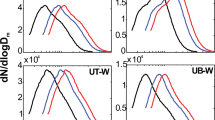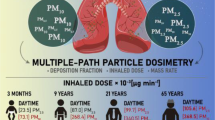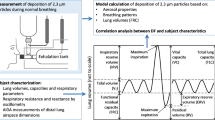Abstract
The paper presents an integrated methodology that combines experimental and modeling techniques and links exposure to airborne particulate matter (PM) with internal dose in the respiratory system and burden in adjacent tissues over a period of time. The methodology is used to estimate doses in the respiratory systems of elders that reside in 10 elderly care centers (ECCs) in the metropolitan area of Lisbon. Measurements of PM were performed in the ECCs and combined with a time-budget survey for the occupants. This information served as input to the first model that estimated particle doses in the different regions of the respiratory tract of the elderly, and then a second model was used to calculate particle build-up in the alveolar region, the interstitium and the hilar lymph nodes of the elders over a 5-year exposure period. It was found that in 5 years of continuous exposure to the average particle concentration measured over all ECCs, 258 mg of all particles are deposited on the surface of the alveoli of which 79.6% are cleared, 18.8% are retained in the alveolar region, 1.5% translocate to the hilar lymph nodes, and 0.1% are transferred to the interstitium.









Similar content being viewed by others
References
Almeida SM, Silva AV, Sarmento S (2014) Effects of exposure to particles and ozone on hospital admissions for cardiorespiratory diseases in Setúbal, Portugal. J Toxicol Environ Health A 77(14–16):837–848
Almeida-Silva M, Almeida SM, Wolterbeek HT (2014c) Multi-elemental characterization of indoor aerosols in elderly care centers. J Radioanal Nucl Chem 300:679–684
Almeida-Silva M, Almeida SM, Gomes JF, Albuquerque PC, Wolterbeek HT (2014b) Determination of airborne nanoparticles in elderly care centers. J Toxicol Environ Health A 77(14–16):867–878
Almeida-Silva M, Almeida SM, Pegas PN, Nunes T, Alves CA, Wolterbeek HT (2015) Exposure and dose assessment to particle components among an elderly population. Atmos Environ 102:156–166
Almeida-Silva M, Wolterbeek HT, Almeida SM (2014a) Elderly exposure to indoor air pollutants. Atmos Environ 85:54–63
Andersen ZJ, Wahlin P, Raaschou-Nielsen O, Ketzel M, Scheike T, Loft S (2008) Size distribution and total number concentration of uktrafine and accumulation mode particles and hospital admissions in children and the elderly in Copenhagen, Denmark. Occup Environ Med 65:458–466
Chao C, Wong K (2002) Residential indoor PM10 and PM2.5 in Hong Kong and the elemental composition. Atmos Environ 36:265–277
Chen C, Zhao B (2011) Review of relationship between indoor and outdoor particles: I/O ration, infiltration factor and penetration factor. Atmos Environ 45:275–288
Eurostat (2003) DAI-EPT results analysis. http://en.eustat.es/elementos/ele0003200/ti_2003_Time_Budget_Survey_Results_analysis/inf0003219_i.pdf
Eurostat (2006) Christel Aliaga, How is the time of the women and men distributed in Europe? http://epp.eurostat.ec.europa.eu/cache/ITY_OFFPUB/KS-NK-06-004/EN/KS-NK-06-004-EN.PDF
Findeisen W (1935) Uber das Absetzen kleiner, in der Luft suspendierter Teilchen in der menschlichen Lunge bei der Atmung. Arch Ges Physiol 236:367–379
Fisher K, Robinson J (2011) Daily life in 23 countries. Soc Indic Res 101:295–304
Hussein T, Löndahl J, Paasonen P, Koivisto AJ, Petäjä T, Hämeri K et al (2013) Modeling regional deposited dose of submicron particles. Sci Total Environ 458(460):140–149
ICRP (1994) Human respiratory tract model for radiological protection. Annals of the ICRP. ICRP Publication 66, 24(1-3). ISBN 0 08 041154 1
ILO, UNep, WHO (2000) Environmental health criteria 214: human exposure assessment
Jones N, Thornton C, Mark D, Harrison R (2000) Indoor/outdoor relationships of particulate matter in domestic homes with roadside, urban and rural locations. Atmos Environ 34(16):2603–2612
Klepeis NE, Nelson WC, Ott WR, Robinson JP, Tsang AM, Switzer P et al (2001) The National Human Activity Patter Survey (NHAPS): a resource for assessing exposure to environmental pollutants. J Expo Anal Environ Epidemiol 11:231–252
Kreyling WG, Möller W, Semmler-Behnke M, Oberdörster G (2007) Paricle dosimetry: Deposition and clearance from the respiratory tract and translocation towards extra-pulmonary sites. In Donaldson K, Borm P (eds) Particle toxicology, Chap. 3. CRC Press, Taylor & Francis, New York, pp 47–74
Lanki T, Ahokas A, Alm S, Janssen NA, Hoek G, De Hartog JJ et al (2007) Determinants of personal and indoor PM2.5 and absorbance among elderly subjects with coronary heart disease. J Expo Anal Environ Epidemiol 17:124–133
Lawson S, Galbally IE, Powell JC, Keywood MD, Molloy SB, Cheng M et al (2011) The effect of proximity to major roads on indoor air quality in typical Australian dwellings. Atmos Environ 45:2252–2259
MacCalman L, Tran CL, Kuempel E (2009) Development of a bio-mathematical model in rats to describe clearance, retention and translocation of inhaled nano particles throughout the body. J Phys Conf Ser 151(1):012028
Martonen TB (1993) Mathematical model for the selective deposition of inhaled pharmaceuticals. J Pharm Sci 82(12):1191–1199
Mitsakou C, Helmis C, Housiadas C (2005) Eulerian modelling of lung deposition with sectional representation of aerossol dynamics. J Aerosol Sci 36:75–94
Mitsakou C, Housadis C, Eleftheriadis K, Vratolis S, Helmis C, Asimakopoulos D (2007a) Lung deposition of fine and ultrafine particles outdoors and indoors during a cooking event and a no activity period. Indoor Air 17:143–152
Mitsakou C, Mitrakos D, Neofytou P, Housiadas C (2007b) A simple mechanistic model of deposition of water-soluble aerosol particles in the mouth and throat. J Aerosol Med 20:519–529
Molloy SB, Cheng M, Galbally IE, Keywood MD, Lawson SJ, Powell JC, Gillett R, Dunne E, Selleck PW (2012) Indoor air quality in typical temperate zone Australian dwellings. Atmos Environ 54:400–407
Morawska L, Afshari A, Bae GN, Buonanno G, Chao CYH, Haninnen et al (2013) Indoor aerosols: from personal exposure to risk assessment. Indoor Air 23:462–487
Nasir ZA, Colbeck I (2013) Particulate pollution in different housing types in a UK suburban location. Sci Total Environ 445(/446):165–176
National Academy of Science (NAS) (1991) Human exposure assessment for airborne pollutants, advances and opportunities. National Academy Press, Washington, DC
Pilou M, Mavrofrydi O, Housiadas C, Eleftheriadis K, Papazafiri P (2013) Computational modeling as part of alternative testing strategies in the respiratory and cardiovascular systems: inhaled nanoparticle dose modelling based on representative aerosol measurements and corresponding toxicological analysis. Nanotoxicology 9(Suppl 1):106–115
Pilou M, Mavrofrydi O, Housiadas C, Eleftheriadis K, Papazafiri P (2015) Computational modeling as part of alternative testing strategies in the respiratory and cardiovascular systems: inhaled nanoparticle dose modeling based on representative aerosol measurements and corresponding toxicological analysis. https://doi.org/10.1007/s11356-018-2661-3 Nanotoxicology 7(s): 113–122
Pope CA, Burnett RT, Thun MJ, Calle EE, Krewski D, Ito K et al (2002) Lung cancer, cardiopulmonary mortality, and long-term exposure to fine particulate air pollution. J Am Med Assoc 287(9):1132–1141
Portaria 353-A/2013 de 4 de Dezembro. https://dre.pt/application/dir/pdf1sdip/2013/12/23501/0000200009.pdf
Sexton K, Callahan MA, Bryan EF (1995) Estimating exposure and dose to characterize health risks: the role of human tissue monitoring in exposure assessment. Environ Health Perspect 3:13–30
Simkhovich BZ, Kleinman MT, Kloner RA (2008) Air pollution and cardiovascular injury: epidemiology, toxicology, and mechanisms. J Am Coll Cardiol 52:719–726
Simoni M, Jaakkola MS, Carrozzi L, Baldacci S, Di Pede F, Viegi G (2003) Indoor air pollution and respiratory health in the elderly. Eur Respir J 40:15–20
Tena AF, Clarà PC (2012) Deposition of inhaled particles in the lungs. Arch Bronconeumol 48(7):240–246
Tran CL, Jones AD, Cullen RT, Donaldson K (1999) Mathematical modeling of the retention and clearance of low-toxicity particles in the lung. Inhal Toxicol 11(12):1059–1076. https://doi.org/10.1080/089583799196592
Tran L, Kuempel E (2007) Biologically based lung dosimetry and exposure-dose-response models for poorly soluble inhaled particles. In: Donaldson K, Born P (eds) Particle toxicology. CRC Press, New York, pp 351–386
Urso P, Cattaneo A, Garramone G, Peruzzo C, Cavallo DM, Carrer P (2015) Identification of particulate matter determinants in residential homes. Build Environ 86:61–69
Viegas C, Almeida-Silva M, Quintal GA, Wolterbeek HT, Almeida SM (2014) Fungal contamination assessment in Portuguese elderly care centers. J Toxicol Environ Health A 77(1–3):14–23
Weibel ER (1963) Morphometry of the human lung. Springer Verlag, Berlin-Göttingen-Heidelberg
Yeh H, Schum GM (1980) Models of human lung airways and their application to inhaled particle deposition. Bull Math Biol 42:461–480
Acknowledgements
The study would not be possible without the assistance of the Câmara Municipal de Loures, by Dr. Luzia Sousa and Dr. Beatriz Reis. C2TN/IST authors gratefully acknowledge the FCT support through the UID/Multi/04349/2013 project.
Funding
We gratefully acknowledge Fundação para a Ciência e Tecnologia (FCT) for funding M. Almeida-Silva PhD fellowship (SFRH/BD/69700/2010) and S.M. Almeida contract (IF/01078/2013).
Author information
Authors and Affiliations
Corresponding author
Additional information
Responsible editor: Philippe Garrigues
Highlights
• Ten percent of the mass of the inhaled particles per breath ends up in the alveolar-interstitial.
• In the bedroom, 79% of the inhaled particle mass deposits.
• In the living room, 90% of the inhaled particle mass deposits.
• Ninety-seven percent of the daily dose in mass can be attributed to particles sized between 2.5–10 μm.
Rights and permissions
About this article
Cite this article
Almeida-Silva, M., Pilou, M., Housiadas, C. et al. Internal dose of particles in the elderly—modeling based on aerosol measurements. Environ Sci Pollut Res 25, 23645–23656 (2018). https://doi.org/10.1007/s11356-018-2661-3
Received:
Accepted:
Published:
Issue Date:
DOI: https://doi.org/10.1007/s11356-018-2661-3




